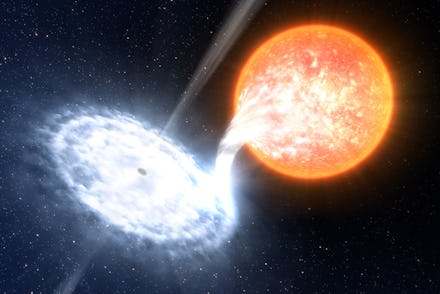A Telescope the Size of Earth Just Captured a Supermassive Black Hole Eating a Star

Astronomers just got their most precise look to-date at a supermassive black hole gobbling up a star. The research could help us figure out what exactly happens when stars get eaten by black holes — and why those black holes sometimes shoot out jets of particles at nearly the speed of light.
If a star strays too close to a black hole, the black hole will start sucking in the stellar material:
Some of that material collects in a disc around the black hole and then gets ejected out in bright "jets" of particles (those straight, skinny lines you see in the GIF above) that travel at nearly the speed of light.
The international team of astronomers behind this new research studied some of these jets, first discovered in 2011 in a galaxy about 3.9 billion light-years away, according to a press release from Chalmers University of Technology. Astronomers named the event Swift J1644+57.
Astronomers were able to get an unprecedented close up view of the jets coming from Swift J1644+57 by using a system of radio telescopes that linked up to create a giant, Earth-sized telescope called the European VLBI Network (EVN).
The sharp view of the jets could give us more insight into how they form.
"Observations with the next generation of radio telescopes will tell us more about what actually happens when a star is eaten by a black hole — and how powerful jets form and evolve right next to black holes," astronomer Stefanie Komossa said in a statement.
Read more: